*FYI - this post may contain affiliate links, which means we earn a commission at no extra cost to you if you purchase from them. Also, as an Amazon Associate I earn from qualifying purchases. Check out our Privacy Policy and Disclosure. for more info.
I started my blog, Practical Wanderlust, in June 2016. 1 year later, we average 60k page views monthly. I’m often asked the secret to my success. And I’ve love to just be like “~follow your dreams and believe in yourself~” or whatever, but let’s be honest: that’s totally useless. Can’t nobody develop a traffic-driving strategy based off of dreams. So let me be totally honest with you. The secret to my blog success is Pinterest. Around 20k of my monthly traffic comes from Pinterest, as it has steadily for the past 6 months. When I was first building my Pinterest account, I spent an hour a day on Pinterest – that’s since changed , but it was crucial to my success initially. The big question I always get asked is: but what do I DO on Pinterest? Look, there’s no shame in asking this question: it may sound obvious, but that makes it the most difficult of all. There are so many things you can spend your time doing on Pinterest, like re-pinning interior design inspiration for the house you can’t afford or saving pictures of the cute puppies you aren’t allowed to have in your tiny apartment, but not all of them will drive traffic to your blog, brand, or business. Let’s dive in to discover what you should be doing to slay your Pinterest game!
I receive around 20k monthly visitors to my blog from Pinterest. My Pinterest traffic has been steady for the past 6 months. It’s been the key to my blog’s success!I get asked a lot of questions about Pinterest from my Pinterest Consultation clients, and I do my best to answer each one individually. But sometimes, the same questions comes up over and over again. So I’d decided to answer these frequently asked questions as part of my Pinterest Makeover Series! Because it’s educational for you, but also it saves me a lot of repetitive explaining. Let’s be real.
Today, we’re focusing on one that a lot of people wonder, but for some reason, not a lot of people want to admit to wondering: what do I DO on Pinterest? Like, OK, I have a profile, I gave it a Kickass Profile Makeover and it looks really great… uh, now what? Do I just sit and wait for the traffic to roll in? What am I missing here?!
First of all, don’t feel bad if this question is on your mind. You are so not alone. That feeling of “but wtf even is this?” It’s exactly how I feel when I open up Twitter. Like … what is even happening on this site?! Luckily, I’m not in charge of our Twitter guides. Christina is!
There are really only 2 over-arching strategies when it comes to Pinterest: the sharing of your own content and the sharing of other people’s content. Both are equally important to grow your Pinterest account and drive traffic to your blog. But they’re very different, and require completely different strategies.
Let’s start with the most exciting one: sharing your own content on Pinterest! After all, that’s what will directly contribute to clicks to your site and traffic from Pinterest.
Sharing Your Own Content to Pinterest
Putting your own content on Pinterest is the exciting part for a blogger. It’s what brings visitors to your blog, builds loyal readerships, grows your email subscriber list, etc etc. It’s awesome.
But it’s … complicated
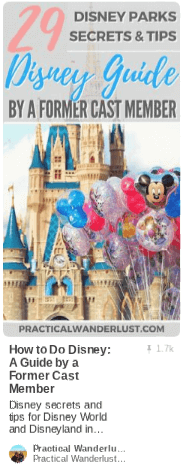
For starters, you don’t want to just share any old content from your site onto Pinterest. Pinterest is a search engine, but it’s a VISUAL search engine. So, the content that works best on Pinterest is visually appealing and enticing. It’s inspiring, motivating, and informative. And it’s vertical.
Yes, vertical.
Vertical content works best on Pinterest. It’s rare that a horizontal photo takes off, goes viral, and/or drives traffic to your site. Frankly, I don’t bother pinning any horizontal images from my blog at all. If I have a good vertical image in a blog post, I definitely will share that to Pinterest, and generally it gets lots of shares – but not necessarily clicks.
Why? Because people are saving it to look at, not to click on. They’re saving it for inspiration, not clicking through for information.
I know what you’re thinking: but I want them to go to my blog and read stuff! I want them to be informed and entertained! There’s so much more where that ONE vertical photo came from that they’re totally missing out on!
Well, that’s where Pinterest templates come in. A Pinterest template is basically a Pinterest-optimized graphic, meant to communicate the content of your blog visually to Pinterest users, that links to your site. It’s like having a Twitter header, or a feature photo, or a title image just for Facebook – except for Pinterest. It’s a combination of images and text, and the text is key: that’s where the visual search engine bit comes in.
The text on a Pinterest optimized image (henceforth, I’m going to refer to it as a Pin, because it’s less of a mouthful) is like visual SEO. It needs to catch the eye of a Pinterest user as they’re scrolling through their feed, and then quickly & clearly communicate the content of your post in a way that makes them want to click on it to go straight to your site.
Easier said than done, right? I’m not going to talk about how to make Pin templates in this post – that’s an entire future post that I’ll be writing very soon. But I want you to understand what a Pin IS, because that’s what I’m talking about when I’m referring to sharing your Pins on Pinterest.
OK, so, you have a beautiful and totally clickable Pin. You’ve uploaded it to your blog post, and pinned it on Pinterest. Now what?!
Now, you get to work. It’s time to Launch That Pin.
How to Launch New Content on Pinterest
What the heck do I mean by “launching” a pin? I’m referring to giving a pin a boost – getting it off the ground and circulating, so it can start getting engagement, like re-pins and clicks (yay, clicks!).
There are a few ways to do this. Here is my complete Launch strategy. I like to refer to strategy as strat when I’m being really strategic and serious, so:
Launch Strat
- I share my Pin to my Best Of Blog board
- I share my pin to a few Tailwind Tribes
- I drop my pin in a Facebook re-pin thread
- I share my pin to every single one of my Group Boards on Pinterest
- I share my pin to every relevant one of MY boards on Pinterest
Annnnd that’s Launch. By the time a pin has been fully Launched, I expect it to have at least 100 re-pins. Between my 50 group boards and another 50+ people sharing it from a Facebook re-pin group, 100 is totally doable.
For me, 100 is my base number. Any pin below 100 hasn’t been given the proper chance to succeed on Pinterest.
Your number will probably be different. For starters, trying to keep track of 50 group boards is insane and requires things like spreadsheets and organization, which is a whole thing. And a 50-person re-pin thread means manually pinning 50 other pins, which takes a long AF time. So maybe your target number is only 50, and that’s totally fine! Find a number that works for you, and make that your goal for every new pin.
Sharing My Older Content on Pinterest
Launch is all well and good for a new pin, but what about an older pin that needs a boost? Maybe a pin that never took off, or an old post that you just re-vamped?
For older pins, I typically find that Launch is enough to set it and forget it for a few months – it should get organic growth, re-pins, and traffic during that time.
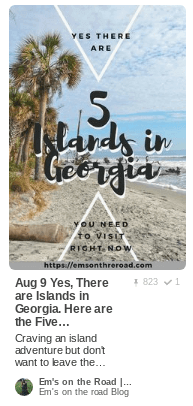
I do have automatic re-sharing set up on Boardbooster using the Campaigns feature to keep my pins regularly sharing to my group boards and personal boards without having to manually share them. More to come on Boardbooster and other automatic Pinning tools in a future post.
For older content that I’ve revamped, I make a whole new pin and go through the Launch process with it as if it’s a brand new pin!
What about an old pin that never took off? I might give it a brand new pin to see if that pin works better. Or, I might give it another Launch – so long as it’s been plenty of time since I did it the first time, so I’m not spamming people with the same pin again.
You can definitely throw your Pin into a Facebook re-pin group again after a while, too. And don’t forget to circulate it occasionally in Tailwind Tribes. If you haven’t tried Tailwind yet, you can use Tribes for free! Sign up for Tailwind here.
The beauty of Pinterest is that once you get a pin circulating, it tends to continue circulating on its own! So Launch is the most important part of my Pinning strategy when it comes to my own content, because it’s crucial for getting my Pin off the ground so I can sit back and watch the traffic roll in.
Now that we’ve talked about sharing YOUR content on Pinterest, let’s cover the other half of your daily Pinterest activity: sharing other people’s stuff on Pinterest.
Sharing Other People’s Content on Pinterest
I know what you’re thinking.
It’s pretty obvious how sharing MY content on Pinterest is going to get me traffic.
How on earth is sharing OTHER people’s content going to benefit me?
Why should I bother?
Well, let me explain.
Why do I need to Share Other People’s Stuff on Pinterest?
Before we dive into the strategy behind pinning other people’s content on Pinterest, let me give you an example. Have you ever noticed that every time you Pin something, Pinterest suggests an account and a board to follow? If not, go log into your Pinterest account and pin something real quick, then look at the bottom of your screen.
Go on, I’ll wait.
Did you see it?
That little suggestion box is one of the keys to growing your Pinterest. You want your profile – and your boards – to pop up to other people, and you want them to click through, take one look at your board/profile, and follow you immediately.
Of course, having a kickass Pinterest profile helps, but often what’s suggested is your board itself, so what’s IN the board really matters.
Now imagine if all you had was your own content.
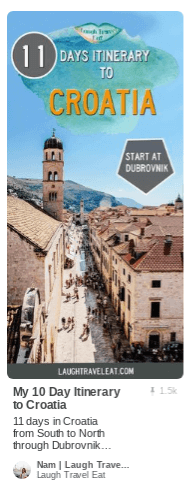
Your board would look boring and repetitive, and chances are, it wouldn’t have more than 50 or 100 pins in it.
Would you follow a board that only seemed to share content from 1 site? Would that interest you as much as a board that serves as a collection of hundreds of beautiful, inspiring, and informative content from all over the web?
Pinterest wants its users to collect lots of pretty images linking to lots of different sites, and save it all to their boards. That’s what it’s designed for. It wasn’t designed for you to only share your own stuff. It’s designed like an interactive bulletin board, where you literally rip out pretty pictures from magazines and pin them up to your board to hang above your desk and inspire you.
You can’t have a robust Pinterest strategy without ignoring the key feature that the entire site is built around.
Sharing other people’s content is part of that foundational Pinterest SEO magical algorithm-tickling goodness that I kept going on and on about in my last Pinterest Makeover post.
It’s what the bulk of your activity on Pinterest will ultimately be comprised of. Your boards will be filled with other people’s content. You’ll log into Pinterest and spend some time sharing other people’s content every single day.
But does sharing other people’s content drive traffic to YOUR site?
Yes. Indirectly, but … yes.
Are you raising one skeptical eyebrow at me right now? Sure, it sounds a little bit counter-intuitive that sharing OTHER people’s pins is going to drive traffic to YOUR site.
But, ultimately, it does. Let me explain.
How does sharing other people’s content drive traffic to MY site?
On Instagram, popularity and quality is measured with “likes.” On Google, it’s measured with backlinks. On Pinterest, it’s measured with engagement: clicks, saves, re-pins, “Tried It”, Thumbs Up, etc.
The Pinterest algorithm thrives on engagement. The more engagement your pins receive – no matter where they link back to – the higher your content will rank in Pinterest’s search engine (because Pinterest is, ultimately, a search engine).
Pinning high quality content that lots of other people engage with signals to Pinterest that you’re a high quality user with good taste, which means ALL of the content you Pin gets a boost in the Pinterest algorithm, INCLUDING your own. So yes, pin that inspirational quote with 20k shares. Jump on that bandwagon. Go to Repinned and find a bunch of popular pins in your niche to share. It’s a quick ticket to exposure-town.
On the flip side, if you pin poor quality content that doesn’t get a much engagement at all, Pinterest will judge the sh** out of you and subsequently tank your exposure, which means tanking all of your pins in its search rankings – including pins that link back to YOUR site!
Always, always, always pin for QUALITY over QUANTITY.
That said, pin a LOT of quality stuff. Consistent, frequent (ideally, daily) pinning indicates to Pinterest that you’re a high quality user. And you want Pinterest’s algorithm to favor you, because then ALL of your content – your boards, your profile, your pins, and the pins linking back to your site – will rank higher in the all-mighty Pinterest search results. And not just search: related pins, Front Page pins, everywhere.
It’s like Google on crack.
It all comes back to this simple (and very mathematical) equation:
You can also break it down step by step, like this:
- Pin lots of high quality content
- Get lots of engagement on that content
- Pinterest thinks you’re a high quality user (thanks, Pinterest!)
- Pinterest’s algorithm ranks your pins higher, including the ones linking to your site
- Your pins get more exposure, which gives you a higher chance of getting clicks to your site.
So, the more high-quality content from other people that you share to your profile, the better. Quality trumps quantity – don’t just share ugly or irrelevant pins just to be active on Pinterest – but what you really want to do on Pinterest is to share a lot of high-quality content that will appeal to your readers & will relate to your niche.
This is a really important point, so I’m going to summarize it one last time to really drill it home:
By frequently pinning high quality pins that are in turn re- pinned or otherwise engaged with (essentially telling Pinterest that you have good taste in content) your account & Pinterest boards will be suggested to other accounts in various places on Pinterest, boosting your exposure. In turn, every time someone follows you or one of your boards, they’re more likely to see the pins you’ve created for your own site popping up on their “front page” (more on the front page later), which means they’re more likely to save your blog’s pins on their own boards, giving you even more exposure, boosting your pins, so and and so forth, which ultimately drives traffic back to your blog!
How do I find other people’s content to share?
Finding people’s content to share on Pinterest isn’t difficult. Like I said, that’s what the entire site was built for.
You can always creep other people’s boards to source content from (*cough* like mine *cough*), or you can use the search bar. Searching on Pinterest is a reliable way to find good stuff to pin – and it’s how lots of regular Pinterest users are interacting with Pinterest. Pinterest IS a search engine, after all.
But using the search bar requires like, thinking… and typing. Both of which take effort, and I’m lazy. So let’s talk shortcuts.
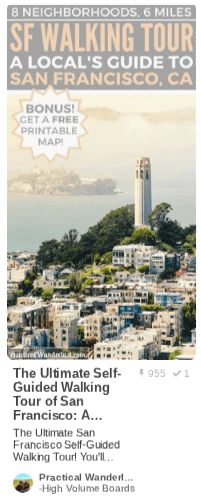
The easiest way to find great content is to develop a useful front page on Pinterest. Remember when I mentioned the “front page” earlier? I’m a big front page fan. It’s the perfect place for lazy people like me to find great content that fits my boards and my niche. And it could not be easier to locate.
Your front page is what shows up as soon as you log into your Pinterest account. It’s filled with content that Pinterest thinks you’re interested in, based on whatever activity you’ve already done on Pinterest. It’s adaptive, and will evolve and change with every action you take on Pinterest. Follow a couple of travel bloggers, follow a few travel boards, do a couple of searches and pin some stuff about travel to your own boards, and boom: your front page will be bursting with gorgeous pins related to travel. And it will continue to serve up new, different, and useful content every time you do anything on Pinterest. It’s hugely helpful!
Oh, and by the way … when I talk about Pinterest SEO and the all-important ~algorithm~, I’m not just talking about search results in the traditional sense: like, what shows up when someone types in a search in the search bar. I’m also talking about the Front Page.
You want pins that link to your site to show up on other people’s front pages, especially people who are interest in whatever you’ve written a blog post about and created a pin for. As soon as they log in, bam: there’s your gorgeous pin, ready to click, without them even having to type anything in at all. That’s the magic of Pinterest: it knows what you’re interested in before you even search for anything. Creepy … but kinda cool. Whenever I talk about exposure, picture that: your pin on someone’s front page, perfectly matched to their interests. Powerful stuff.
Anyway, back to YOUR front page. When it comes to finding other people’s content, the best (and easiest) place to start is at your own front page. Sharing other people’s content is, essentially, not much more than browsing and saving stuff to your own boards. But you have to do it consistently: every single day, you should pin a few things to your own boards.
By the way, remember those “suggested profiles/boards” that Pinterest pops up whenever a user pins something? Don’t ignore them! Following relevant suggested boards and profiles is a great way to build your front page …. AND organically grow your followers. I follow nearly every single travel profile and board suggested by Pinterest, as long as it’s relevant to my niche. Unlike Instagram, there’s not really a downside to following massive quantities of boards and profiles on Pinterest. Even following a few out-of-niche boards and users won’t affect your front page too much: the Pinterest algorithm will always build your front page from scratch based on whatever you’ve pinned most recently.
How do I decide which pins to save to my Pinterest boards, and which to skip?
There are so many Pins on Pinterest, it can be overwhelming. Should you just dive right in and Pin everything on your front page?
I don’t recommend it. Instead, you should be super picky about what you save to your own boards. Never pin anything that doesn’t represent your blog, your brand, your niche, and your values.
If you’re a budget couple’s travel blog (hey, that’s me!) you shouldn’t be pinning content about luxury and family travel. Your readers will be confused, and if they see your pins show up on their front page, they might unfollow you – which sucks, and also sends bad vibes to the all-mighty Pinterest algorithm (and yes, I’ve experienced this first hand, before I took this rule to heart).
Similiarly, if a pin rubs you the wrong way – let’s say it features someone riding an elephant, and you’re vehemently against harmful and exploitative elephant tourism (*AHEM*) – don’t pin it. Your pins should reflect you and your blog 100%.
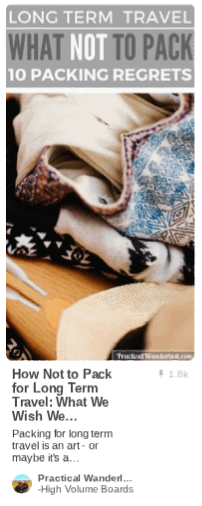
Pinning content that reflects your blog is a start. The next thing to consider when pinning other’s pins is quality. Remember that you want Pinterest to suggest your profile & boards whenever other people pin stuff that you’ve pinned. Well, that means you need to post content that other people will want to pin!
This has a lot to do with personal taste and knowing your own niche, but essentially, only pin high-quality, attractive pins that fit your niche. That means seeking out pins that are eye-catching, visually appealing, and link directly to high quality content that appeals to your reader … and passing on everything else.
Yes, you need to be pinning regularly and frequently, so quantity IS important … but so does quality. Don’t pin an ugly pin that links to a sub-par page just for the sake of pinning something.
Your reader follows you because they trust you to recommend content that will appeal to them, just like YOUR content appeals to them, so never violate that by pinning something that your reader wouldn’t like. Not only will this make the content you share get pinned frequently – signalling to Pinterest that you’re a high quality active user who also has great taste (stop it, Pinterest, I’m blushing!) – but you will cultivate a visually cohesive and appealing profile.
By always staying true to your quality standards and pinning with your reader in mind, of your boards will look gorgeous, deliver useful and engaging content, and readers in your niche will follow you knowing that you will, in turn, fill their feeds with gorgeous, inspiring, high quality pins and content. Pinterest is all about being motivated and inspired – and saving or “bookmarking” pages visually to refer to later – so it’s important that your reader gets that “oooh I want to go there/make that/try that” excited feeling when they look at your boards.
Start Slaying the Pinterest Game
To help you get your own Launch process started, we’ve compiled a BUNCH of awesome resources for Pinterest. Sign up to get access to ALL of our free Pinterest downloadable worksheets and templates PLUS access to all of our other goodies, too! As a bonus for subscribing, we’ll send you the 5-Step Pinterest Profile Checklist and help you complete it with the Pinterest Profile Challenge.
Whew – that was a LONG post. If you’re still with me, mad props. You’re rad.
Are you feeling overwhelmed with the DIY approach? Let me give you a Pinterest Makeover! Just call me Bibbidy Bobbidy Whatserface, but for Pinterest. It’s a bit like waving a magic wand, only with more video chatting and graphic design.
Together, we’ll work through every step necessary to make your Pinterest a thriving, traffic-driving powerhouse. Through video chats and screen-sharing, I’ll answer all of your questions, walk you through each click, talk you through each strategy, and even help you design your pins. By the end of your Pinterest makeover, you’ll be well on your way to achieving massive traffic to your blog from Pinterest! Spots are limited, so head over to my Pinterest Consultation page and end me a message.
Do you have any questions about sharing your own content or sharing other people’s content? Leave me a comment below!
Oh and hey, since this post is about Pinterest … how about saving it on Pinterest? Note: You can find the full-sized image by clicking the “Pin It” button.
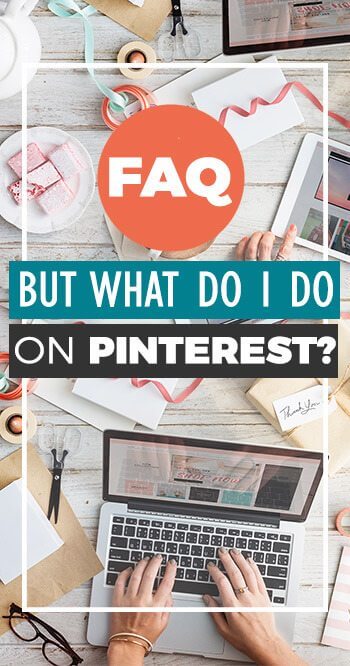


Hello Lia, you mentioned you enter your pins on re-pin threads as part of the “Launch” phase (I have seen your pins in some!). You also make emphasis on the importance to pin high quality, beautiful pins. On the sharing threads, there are (a lot of) pins that are not aesthetically pleasing (some of them should not even be considered pins). How do you balance those two aspects?
That’s a really good point. There are a lot of solutions that people have tried to avoid this: some have a single board that they throw everything into regardless of quality, some people pin unwelcome pins to group boards. Of course the best bet is to join really high quality re-share threads but that’s much easier said than done! Sometimes the benefits outweigh the risks, though.
Good to know your perspective on this. I tend to put those in a specific board (like you mentioned).
great tips and easy to follow that strategy. At the moment my Pinterest is still not as used as it could be but I try to put some focus on it
Thank you so much for this! I’ve been trying to get my head around Pinterest and this just answered so many questions! As I look at my boards, I see that I may have made a couple of less than ideal (uninformed, newbie) choices on what I’ve re-pinned. What do you recommend? Do I keep them and just focus on high quality content going forward or do I remove them from my boards?
If it’s just a few, you can definitely clean it up. But if it’s going to be an enormous undertaking, don’t bother – it doesn’t affect your traffic, just your aesthetic. Just pin a bunch of stuff on top of it and get it buried!
That said, if you don’t clean it up now, you won’t be able to use an automation function like Boardbooster’s Looping tool in the future. Something to consider down the road.
Thanks so much!
Great tips! I do have one question, though… in terms of only pinning GREAT content that fits your brand, how do you handle re-pin threads?
That’s a great question. If you can, try to find a re-pin community that allows you to pin anything that doesn’t fit your brand into a group board. That way you can pin it to a group board that’s a better fit. Like, I’m in exactly 1 family travel board solely for the purpose of funneling re-pin pins there. Everyone wins: my account stays clean, and the pin creator gets matched to a better audience. But be careful, because not every re-pin group is OK with that! Always follow the group’s rules.
I didn’t know there were any groups that permit it! Can you message me the group name?
So informative and useful tips! I’m definitely gonna try many of your suggestions starting now. Thank you so much for a great post!
You’re so kind! Thanks Natalie!
Hi! This is the best post ever on Pinterest! Thank you so much!
I have one newbie question: in the launch, when I’m saving a new Pin in my own relevant boards and all group boards (points 4 &5), can I do this saving to all of those boards within the same day, in one moment as a big ”lump”?
Hi! Do you know when your Pinterest Consultation service will be opening back up? I’m very interested! Could I please be notified?
I have been scouring the internet for a basic run down on how to develop content for a small company’s Pinterest page….TAHNK YOU! This was like hitting the jack pot. Very very very helpful resources!
I’m so glad we could help, Ana!
Hi Lia! Thanks for this amazing post. I’m really tried to build my engagement with Pinterest and I have no idea what I’m doing wrong, so I’m going to try out your makeover tips and the pinning tips from this post! One thing I’m confused about is the launch. If you pin your Pin (forgive me) to several group boards and to your own related boards, doesn’t it show up a bunch of times in your “latest Pins” feed? Or do you create a bunch of different versions of the same Pin? Or am I missing a feature that allows you to create a Pin and then rePin it to different boards yourself? Am I making any sense? Are you still reading? Bueller? Bueller?